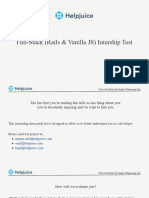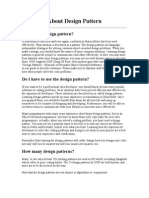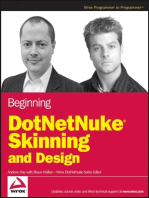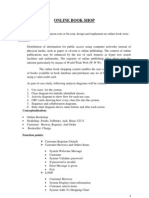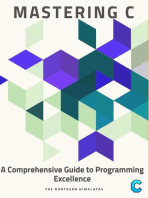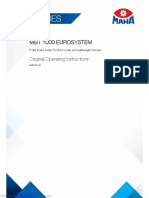0 ratings0% found this document useful (0 votes)
242 viewsFactory Method Design Pattern
The document discusses the Factory Method design pattern. It begins by defining Factory Method as defining an interface for creating objects but allowing subclasses to determine which class to instantiate. It then provides the class diagram and participants. The creator declares the factory method and subclasses override it to return the appropriate concrete product. The benefits are eliminating hardcoding of classes and enabling subclasses to customize object creation. Usage examples include not knowing object classes ahead of time and delegating responsibility to subclasses. The summary concludes by describing a code example of a Painting class using factory methods to return different Shape objects depending on the drawing condition.
Uploaded by
parveenkarthiCopyright
© © All Rights Reserved
Available Formats
Download as DOCX, PDF, TXT or read online on Scribd
0 ratings0% found this document useful (0 votes)
242 viewsFactory Method Design Pattern
The document discusses the Factory Method design pattern. It begins by defining Factory Method as defining an interface for creating objects but allowing subclasses to determine which class to instantiate. It then provides the class diagram and participants. The creator declares the factory method and subclasses override it to return the appropriate concrete product. The benefits are eliminating hardcoding of classes and enabling subclasses to customize object creation. Usage examples include not knowing object classes ahead of time and delegating responsibility to subclasses. The summary concludes by describing a code example of a Painting class using factory methods to return different Shape objects depending on the drawing condition.
Uploaded by
parveenkarthiCopyright
© © All Rights Reserved
Available Formats
Download as DOCX, PDF, TXT or read online on Scribd
You are on page 1/ 15
1
Factory Method Design Pattern, UML diagram,
Java Example
Definition
Class Diagram
Participants
Benefits
Usage
Example
Definition
Define an interface for creating an object, but let subclasses decide which class to
instantiate. Factory Method lets a class defer instantiation to subclasses.
Class Diagram
Factory Method pattern is a simplified version of Abstract Factory pattern. Factory
Method pattern is responsible of creating products that belong to one family, while
Abstract Factory pattern deals with multiple families of products.
The official GoF Factory Method UML diagram (above) can be represented as in
diagram below which uses the same terminology as Abstract Factory UML diagram:
2
Participants
Product
o defines the interface of objects the factory method creates.
ConcreteProduct
o implements the Product interface.
Creator
o declares the factory method, which returns an object of type Product.
Creator may also define a default implementation of the factory
method that returns a default ConcreteProduct object.
o may call the factory method to create a Product object.
ConcreteCreator
o overrides the factory method to return an instance of a
ConcreteProduct
Benefits
Eliminates the needs to bind application classes into your code. The code
deals woth interfaces so it can work with any classes that implement a certain
interface.
Enables the subclasses to provide an extended version of an object, because
creating an object inside a class is more flexible than creating an object
directly in the client.
Usage
When a class cannot anticipate the class of objects it must create.
When a class wants its subclasses to specify the objects it creates.
Classes delegate responsability to one of several helper subclasses, and you
want to localize the knowledge of which helper subclasses is the delegate.
3
(II)
Factory Method
Definition
Provides an abstraction or an interface and lets subclass or implementing classes decide
which class or method should be instantiated or called, based on the conditions or
parameters given.
Where to use & benefits
Connect parallel class hierarchies.
A class wants its subclasses to specify the object.
A class cannot anticipate its subclasses, which must be created.
A family of objects needs to be separated by using shared interface.
The code needs to deal with interface, not implemented classes.
Hide concrete classes from the client.
Factory methods can be parameterized.
The returned object may be either abstract or concrete object.
Providing hooks for subclasses is more flexible than creating objects directly.
Follow naming conventions to help other developers to recognize the code
structure.
Related patterns include
o Abstract Factory , which is a layer higher than a factory method.
o Template method, which defines a skeleton of an algorithm to defer some
steps to subclasses or avoid subclasses
o Prototype, which creates a new object by copying an instance, so it
reduces subclasses.
o Singleton, which makes a returned factory method unique.
Examples
To illustrate such concept, let's use a simple example. To paint a picture, you may need
several steps. A shape is an interface. Several implementing classes may be designed in
the following way.
interface Shape {
public void draw();
}
class Line implements Shape {
Point x, y;
Line(Point a, Point b) {
x = a;
4
y = b;
}
public void draw() {
//draw a line;
}
}
class Square implements Shape {
Point start;
int width, height;
Square(Point s, int w, int h) {
start = s;
width = w;
height = h;
}
public void draw() {
//draw a square;
}
}
class Circle implements Shape {
....
}
class Painting {
Point x, y;
int width, height, radius;
Painting(Point a, Point b, int w, int h, int r) {
x = a;
y = b;
width = w;
height = h;
radius = r;
}
Shape drawLine() {
return new Line(x,y);
}
Shape drawSquare() {
return new Square(x, width, height);
}
Shape drawCircle() {
return new Circle(x, radius);
}
....
}
...
Shape pic;
Painting pt;
//initializing pt
....
if (line)
pic = pt.drawLine();
if (square)
pic = pt.drawSquare();
if (circle)
pic = pt.drawCircle();
5
From the above example, you may see that the Shape pic's type depends on the condition
given. The variable pic may be a line or square or a circle.
You may use several constructors with different parameters to instantiate the object you
want. It is another way to design with Factory pattern. For example,
class Painting {
...
Painting(Point a, Point b) {
new Line(a, b); //draw a line
}
Painting(Point a, int w, int h) {
new Square(a, w, h); //draw a square
}
Painting(Point a, int r){
new Circle(a, r); //draw a circle
}
...
}
You may use several methods to finish the drawing jobs. It is so-called factory method
pattern. for example,
class Painting {
...
Painting(Point a, Point b) {
draw(a, b); //draw a line
}
Painting(Point a, int w, int h) {
draw(a, w, h); //draw a square
}
Painting(Point a, int r){
draw(a, r); //draw a circle
}
...
}
The above draw() methods are overloaded.
Here is a popular example of Factory design pattern. For example, you have several
database storages located in several places. The program working on the database is the
same. The user may choose local mode or remote mode. The condition is the choice by
the user. You may design your program with Factory pattern. When the local mode is set,
you may instantiate an object to work on the local database. If the remote mode is set,
you may instantiate an object which may have more job to do like remote connection,
downloading, etc.
6
interface DatabaseService {
public DataInfo getDataInfo() throws Exception;
public FieldInfo getFieldInfo() throws Exception;
public void write(FieldInfo fi) throws Exception;
public void modify(FieldInfo fi) throws Exception;
public void delete(FieldInfo fi) throws Exception;
//...
}
class Data implements DatabaseService {
public Data(String fileName) {...};
public Data(URL url, String fileName) {....};
public DataInfo getDataInfo() throws Exception {...};
public FieldInfo getFieldInfo() throws Exception {...};
public void write(FieldInfo fi) throws Exception {...};
public void modify(FieldInfo fi) throws Exception {...};
public void delete(FieldInfo fi) throws Exception {...};
//....
}
class DataManager{
Data data = null;
...
if (local) {
data = new Data(localFile);
...
}
if (remote){
data = new Data(connectRemote, databaseFile);
...
}
data.write(someInfo);
data.modify(someInfo);
....
}
To illustrate how to use factory design pattern with class level implementation, here is a
real world example. A company has a website to display testing result from a plain text
file. Recently, the company purchased a new machine which produces a binary data file,
another new machine on the way, it is possible that one will produce different data file.
How to write a system to deal with such change. The website just needs data to display.
Your job is to provide the specified data format for the website.
Here comes a solution. Use an interface type to converge the different data file format.
The following is a skeleton of implementation.
//Let's say the interface is Display
interface Display {
//load a file
public void load(String fileName);
//parse the file and make a consistent data type
7
public void formatConsistency();
}
//deal with plain text file
class CSVFile implements Display{
public void load(String textfile) {
System.out.println("load from a txt file");
}
public void formatConsistency() {
System.out.println("txt file format changed");
}
}
//deal with XML format file
class XMLFile implements Display {
public void load(String xmlfile) {
System.out.println("load from an xml file");
}
public void formatConsistency() {
System.out.println("xml file format changed");
}
}
//deal with binary format file
class DBFile implements Display {
public void load(String dbfile) {
System.out.println("load from a db file");
}
public void formatConsistency() {
System.out.println("db file format changed");
}
}
//Test the functionality
class TestFactory {
public static void main(String[] args) {
Display display = null;
//use a command line data as a trigger
if (args[0].equals("1"))
display = new CSVFile();
else if (args[0].equals("2"))
display = new XMLFile();
else if (args[0].equals("3"))
display = new DBFile();
else
System.exit(1);
//converging code follows
display.load("");
display.formatConsistency();
}
8
}
//after compilation and run it
C:\>java TestFactory 1
load from a txt file
txt file format changed
C:\>java TestFactory 2
load from an xml file
xml file format changed
C:\>java TestFactory 3
load from a db file
db file format changed
In the future, the company may add more data file with different format, a programmer
just adds a new class in accordingly. Such design saves a lot of code and is easy to
maintain.
Return to top
(III) Factory Method
/wEPDwUKLTk5N
home
courses
schedule
registration
careers
contact us
sitemap
about us
login
design
patterns
pattern
design patterns
C#, WPF, ASP.NET, AJAX, PATTERNS
Factory Method Design Pattern
< back to list of patterns
definition
UML diagram
participants
sample code in C#
definition
Define an interface for creating an object,
Better Code
Better Career
Better
Lifestyle
Design Pattern
Framework 2.0
TM
9
framework
ajax design
patterns
wpf design
patterns
resources
training
and
educatio
n for
professio
nal
develope
rs
but let subclasses decide which class to
instantiate. Factory Method lets a class
defer instantiation to subclasses.
Frequency of use: high
return to top
UML class diagram
return to top
participants
The classes and/or objects participating in this
pattern are:
Product (Page)
o defines the interface of objects the factory
method creates
ConcreteProduct (SkillsPage, EducationPage,
ExperiencePage)
o implements the Product interface
Creator (Document)
o declares the factory method, which returns an
object of type Product. Creator may also
define a default implementation of the factory
method that returns a default
ConcreteProduct object.
o may call the factory method to create a
Product object.
ConcreteCreator (Report, Resume)
o overrides the factory method to return an
instance of a ConcreteProduct.
In C# and VB.NET
Click here for details
-- Instant Access --
Instant Download
10
return to top
sample code in C#
This structural code demonstrates the Factory
method offering great flexibility in creating different
objects. The Abstract class may provide a default
object, but each subclass can instantiate an
extended version of the object.
Hide code
// Factory Method pattern -- Structural example
using System;
using System.Collections;
namespace DoFactory.GangOfFour.Factory.Structural
{
// MainApp test application
class MainApp
{
static void Main()
{
// An array of creators
Creator[] creators = new Creator[2];
creators[0] = new ConcreteCreatorA();
creators[1] = new ConcreteCreatorB();
// Iterate over creators and create products
foreach(Creator creator in creators)
{
Product product = creator.FactoryMethod();
Console.WriteLine("Created {0}",
product.GetType().Name);
}
// Wait for user
Console.Read();
}
}
// "Product"
abstract class Product
{
}
// "ConcreteProductA"
11
class ConcreteProductA : Product
{
}
// "ConcreteProductB"
class ConcreteProductB : Product
{
}
// "Creator"
abstract class Creator
{
public abstract Product FactoryMethod();
}
// "ConcreteCreator"
class ConcreteCreatorA : Creator
{
public override Product FactoryMethod()
{
return new ConcreteProductA();
}
}
// "ConcreteCreator"
class ConcreteCreatorB : Creator
{
public override Product FactoryMethod()
{
return new ConcreteProductB();
}
}
}
Output
Created ConcreteProductA
Created ConcreteProductB
This real-world code demonstrates the Factory
method offering flexibility in creating different
documents. The derived Document classes Report
and Resume instantiate extended versions of the
12
Document class. Here, the Factory Method is called
in the constructor of the Document base class.
Hide code
// Factory Method pattern -- Real World example
using System;
using System.Collections;
namespace DoFactory.GangOfFour.Factory.RealWorld
{
// MainApp test application
class MainApp
{
static void Main()
{
// Note: constructors call Factory Method
Document[] documents = new Document[2];
documents[0] = new Resume();
documents[1] = new Report();
// Display document pages
foreach (Document document in documents)
{
Console.WriteLine("\n" +
document.GetType().Name+ "--");
foreach (Page page in document.Pages)
{
Console.WriteLine(" " +
page.GetType().Name);
}
}
// Wait for user
Console.Read();
}
}
// "Product"
abstract class Page
{
}
// "ConcreteProduct"
class SkillsPage : Page
{
}
13
// "ConcreteProduct"
class EducationPage : Page
{
}
// "ConcreteProduct"
class ExperiencePage : Page
{
}
// "ConcreteProduct"
class IntroductionPage : Page
{
}
// "ConcreteProduct"
class ResultsPage : Page
{
}
// "ConcreteProduct"
class ConclusionPage : Page
{
}
// "ConcreteProduct"
class SummaryPage : Page
{
}
// "ConcreteProduct"
class BibliographyPage : Page
{
}
// "Creator"
abstract class Document
{
private ArrayList pages = new ArrayList();
// Constructor calls abstract Factory method
public Document()
{
this.CreatePages();
}
14
public ArrayList Pages
{
get{ return pages; }
}
// Factory Method
public abstract void CreatePages();
}
// "ConcreteCreator"
class Resume : Document
{
// Factory Method implementation
public override void CreatePages()
{
Pages.Add(new SkillsPage());
Pages.Add(new EducationPage());
Pages.Add(new ExperiencePage());
}
}
// "ConcreteCreator"
class Report : Document
{
// Factory Method implementation
public override void CreatePages()
{
Pages.Add(new IntroductionPage());
Pages.Add(new ResultsPage());
Pages.Add(new ConclusionPage());
Pages.Add(new SummaryPage());
Pages.Add(new BibliographyPage());
}
}
}
Output
Resume -------
SkillsPage
EducationPage
ExperiencePage
Report -------
IntroductionPage
ResultsPage
ConclusionPage
SummaryPage
BibliographyPage
This .NET optimized code demonstrates the same
real-world situation as above but uses modern,
15
built-in .NET features.
return to top
You might also like
- 9 Ways BMC Helix Itsm Beats The Competition 2No ratings yet9 Ways BMC Helix Itsm Beats The Competition 213 pages
- Presented By: Yingpeng (Rocky) Wu 2011 Winter SemesterNo ratings yetPresented By: Yingpeng (Rocky) Wu 2011 Winter Semester49 pages
- Creational Design Patterns Structural Design Patterns Behavioral Design Patterns Applying Design Patterns0% (1)Creational Design Patterns Structural Design Patterns Behavioral Design Patterns Applying Design Patterns157 pages
- Distributed Systems: Dr.P.Amudha Associate Professor100% (4)Distributed Systems: Dr.P.Amudha Associate Professor38 pages
- BC0057 - Object Oriented Analysis and DesignNo ratings yetBC0057 - Object Oriented Analysis and Design8 pages
- Introduction To ASP - Netintroduction ToNo ratings yetIntroduction To ASP - Netintroduction To17 pages
- Microsoft Press CSharp Programmer's CookbookNo ratings yetMicrosoft Press CSharp Programmer's Cookbook11 pages
- Project Report On Rich Internet Application For Automatic College Timetable Generation (24th March 2008)100% (1)Project Report On Rich Internet Application For Automatic College Timetable Generation (24th March 2008)112 pages
- Ava Ull Tack Ontent - Ays: Advanced Java/ J2EE JDBCNo ratings yetAva Ull Tack Ontent - Ays: Advanced Java/ J2EE JDBC7 pages
- How To Pass A Silicon Valley Software InterviewNo ratings yetHow To Pass A Silicon Valley Software Interview95 pages
- Full Download Learning JavaScript Design Patterns Addy Osmani PDF DOCX100% (6)Full Download Learning JavaScript Design Patterns Addy Osmani PDF DOCX60 pages
- 5 Must-Know Distributed Systems Design Patterns For Event-Driven Architectures - by Arslan Ahmad - Level Up CodingNo ratings yet5 Must-Know Distributed Systems Design Patterns For Event-Driven Architectures - by Arslan Ahmad - Level Up Coding16 pages
- Study On Rational Rose: Use-Case DiagramNo ratings yetStudy On Rational Rose: Use-Case Diagram4 pages
- Samuel - Object-Oriented Systems Analysis and DesignNo ratings yetSamuel - Object-Oriented Systems Analysis and Design317 pages
- Analysis Node - Js Platform Web Application SecurityNo ratings yetAnalysis Node - Js Platform Web Application Security60 pages
- MIT 820 Architectures For Software Systems and EmergingNo ratings yetMIT 820 Architectures For Software Systems and Emerging26 pages
- Scalable Javascript Application Architecture: Nicholas C. Zakas - @slicknetNo ratings yetScalable Javascript Application Architecture: Nicholas C. Zakas - @slicknet108 pages
- Olaf Musch - Design Patterns With Java - An Introduction-Springer Vieweg (2023)No ratings yetOlaf Musch - Design Patterns With Java - An Introduction-Springer Vieweg (2023)344 pages
- Relational Database Index Design and the Optimizers: DB2, Oracle, SQL Server, et al.From EverandRelational Database Index Design and the Optimizers: DB2, Oracle, SQL Server, et al.5/5 (1)
- Android Studio 3.4 Development Essentials - Kotlin Edition: Developing Android 9 Apps Using Android Studio 3.4, Kotlin and Android JetpackFrom EverandAndroid Studio 3.4 Development Essentials - Kotlin Edition: Developing Android 9 Apps Using Android Studio 3.4, Kotlin and Android JetpackNo ratings yet
- Mastering C: A Comprehensive Guide to Programming ExcellenceFrom EverandMastering C: A Comprehensive Guide to Programming ExcellenceNo ratings yet
- OB 58 OB Ch12 Leadership and FollowershipNo ratings yetOB 58 OB Ch12 Leadership and Followership26 pages
- Upper Assam Road Trip Visiting Namsai ArunachalNo ratings yetUpper Assam Road Trip Visiting Namsai Arunachal1 page
- Bank's Vulnerability To Money LaunderingNo ratings yetBank's Vulnerability To Money Laundering14 pages
- Solution Manual for Materials for Civil and Construction Engineers 3rd Edition by Mamlouk 2024 scribd download100% (11)Solution Manual for Materials for Civil and Construction Engineers 3rd Edition by Mamlouk 2024 scribd download54 pages
- Jurnal Penelitian Transportasi Darat: Kajian Preferensi Masyarakat Dalam Menggunakan LRT JabodebekNo ratings yetJurnal Penelitian Transportasi Darat: Kajian Preferensi Masyarakat Dalam Menggunakan LRT Jabodebek8 pages
- How To Reset Ink Level Canon 30-241 PIXMA IP - MP - MX - MG Series - BCH Technologies Customer Help CenterNo ratings yetHow To Reset Ink Level Canon 30-241 PIXMA IP - MP - MX - MG Series - BCH Technologies Customer Help Center4 pages
- Biostatistics - Mean of Continuous SeriesNo ratings yetBiostatistics - Mean of Continuous Series5 pages
- Recovery of Scattered and Precious Metals From Copper Anode Slime by Hydrometallurgy - A ReviewNo ratings yetRecovery of Scattered and Precious Metals From Copper Anode Slime by Hydrometallurgy - A Review17 pages
- Presented By: Yingpeng (Rocky) Wu 2011 Winter SemesterPresented By: Yingpeng (Rocky) Wu 2011 Winter Semester
- Creational Design Patterns Structural Design Patterns Behavioral Design Patterns Applying Design PatternsCreational Design Patterns Structural Design Patterns Behavioral Design Patterns Applying Design Patterns
- Distributed Systems: Dr.P.Amudha Associate ProfessorDistributed Systems: Dr.P.Amudha Associate Professor
- Project Report On Rich Internet Application For Automatic College Timetable Generation (24th March 2008)Project Report On Rich Internet Application For Automatic College Timetable Generation (24th March 2008)
- Ava Ull Tack Ontent - Ays: Advanced Java/ J2EE JDBCAva Ull Tack Ontent - Ays: Advanced Java/ J2EE JDBC
- Full Download Learning JavaScript Design Patterns Addy Osmani PDF DOCXFull Download Learning JavaScript Design Patterns Addy Osmani PDF DOCX
- 5 Must-Know Distributed Systems Design Patterns For Event-Driven Architectures - by Arslan Ahmad - Level Up Coding5 Must-Know Distributed Systems Design Patterns For Event-Driven Architectures - by Arslan Ahmad - Level Up Coding
- Samuel - Object-Oriented Systems Analysis and DesignSamuel - Object-Oriented Systems Analysis and Design
- Analysis Node - Js Platform Web Application SecurityAnalysis Node - Js Platform Web Application Security
- MIT 820 Architectures For Software Systems and EmergingMIT 820 Architectures For Software Systems and Emerging
- Scalable Javascript Application Architecture: Nicholas C. Zakas - @slicknetScalable Javascript Application Architecture: Nicholas C. Zakas - @slicknet
- Olaf Musch - Design Patterns With Java - An Introduction-Springer Vieweg (2023)Olaf Musch - Design Patterns With Java - An Introduction-Springer Vieweg (2023)
- Relational Database Index Design and the Optimizers: DB2, Oracle, SQL Server, et al.From EverandRelational Database Index Design and the Optimizers: DB2, Oracle, SQL Server, et al.
- Android Studio 3.4 Development Essentials - Kotlin Edition: Developing Android 9 Apps Using Android Studio 3.4, Kotlin and Android JetpackFrom EverandAndroid Studio 3.4 Development Essentials - Kotlin Edition: Developing Android 9 Apps Using Android Studio 3.4, Kotlin and Android Jetpack
- Mastering C: A Comprehensive Guide to Programming ExcellenceFrom EverandMastering C: A Comprehensive Guide to Programming Excellence
- Solution Manual for Materials for Civil and Construction Engineers 3rd Edition by Mamlouk 2024 scribd downloadSolution Manual for Materials for Civil and Construction Engineers 3rd Edition by Mamlouk 2024 scribd download
- Jurnal Penelitian Transportasi Darat: Kajian Preferensi Masyarakat Dalam Menggunakan LRT JabodebekJurnal Penelitian Transportasi Darat: Kajian Preferensi Masyarakat Dalam Menggunakan LRT Jabodebek
- How To Reset Ink Level Canon 30-241 PIXMA IP - MP - MX - MG Series - BCH Technologies Customer Help CenterHow To Reset Ink Level Canon 30-241 PIXMA IP - MP - MX - MG Series - BCH Technologies Customer Help Center
- Recovery of Scattered and Precious Metals From Copper Anode Slime by Hydrometallurgy - A ReviewRecovery of Scattered and Precious Metals From Copper Anode Slime by Hydrometallurgy - A Review
